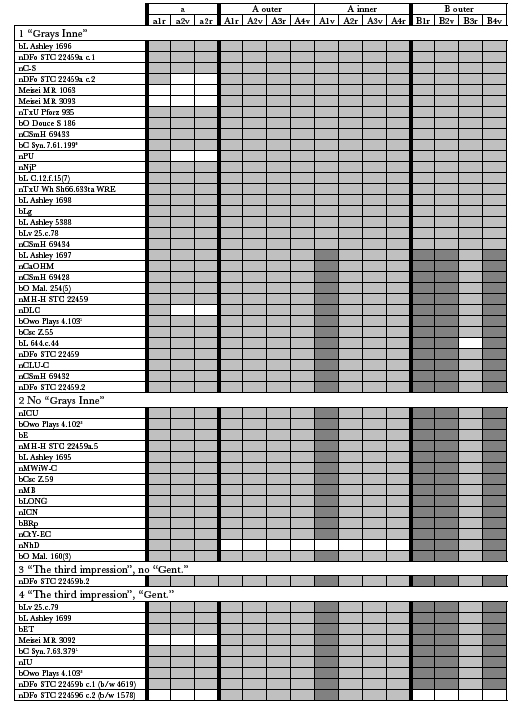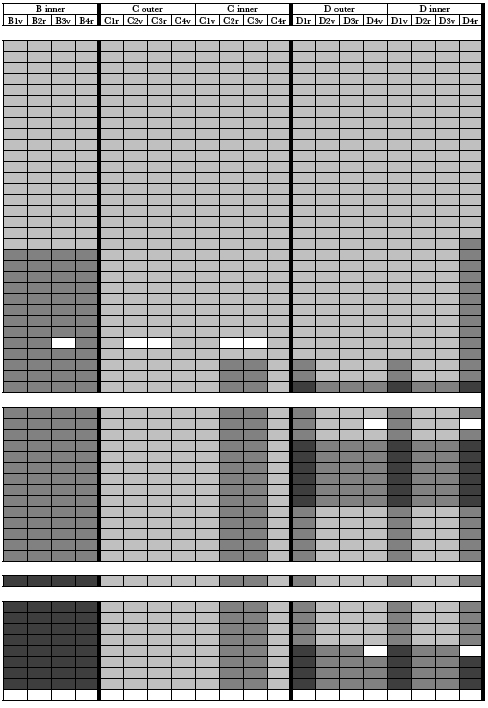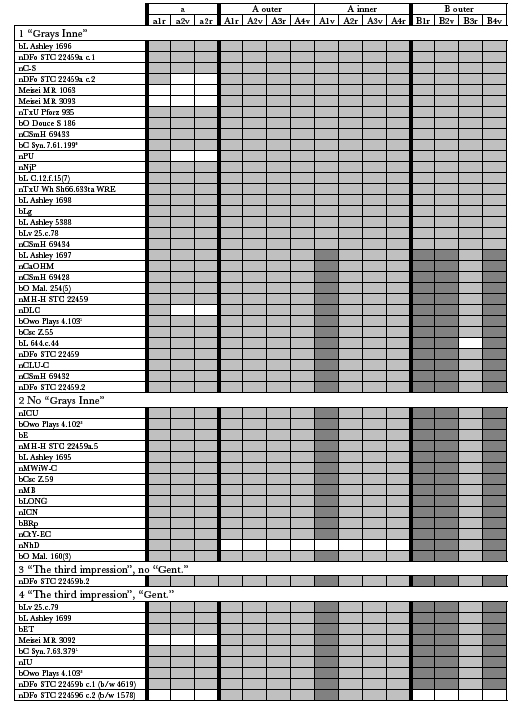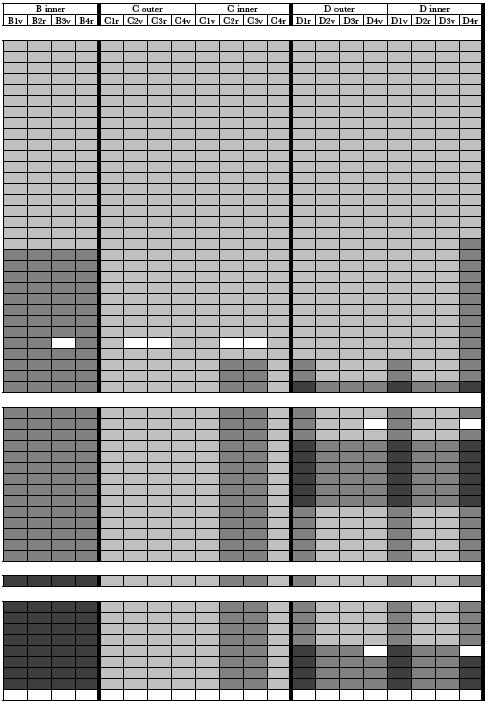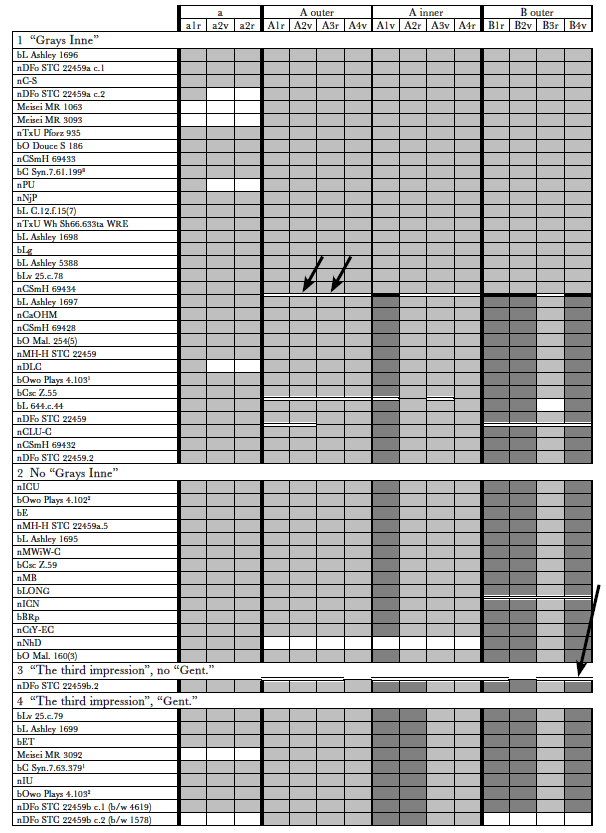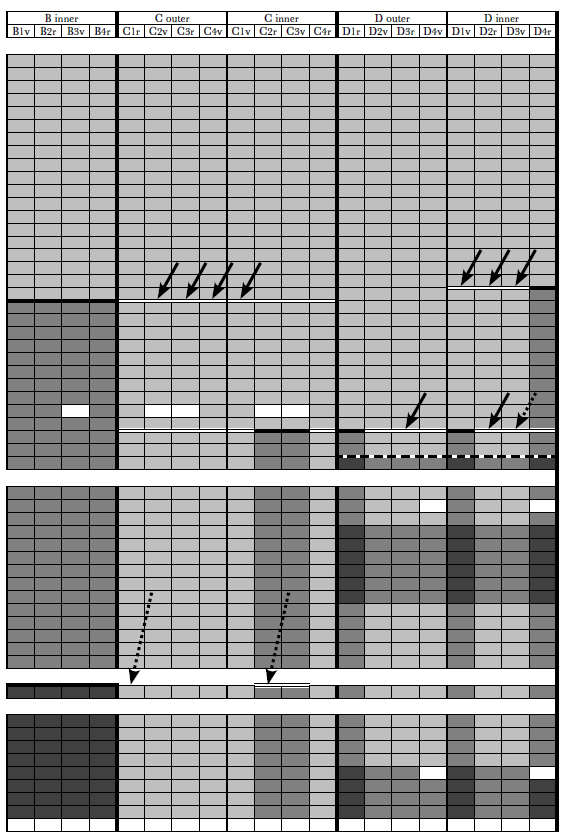| JAMES SHIRLEY'S TRIUMPH OF PEACE:
ANALYZING GREG'S NIGHTMARE
by
STEPHEN TABOR
| ||
THREE PUZZLES
§1. Main Settings
Table 1 shows, in shades of gray, the distribution in surviving copies of
the
completely different settings of each page. The rows of the table correspond
to
the copies or reproductions I have examined, grouped by the four title-page
vari-
ants which are separated by the horizontal white bands. The columns
represent
the pages of each copy grouped by quire and forme. One can immediately
see
what perplexed the earlier bibliographers. Some settings persist throughout
the
print history: the outer formes of quires A and C, for instance, and even
the
title page (a1r), remain substantially the same with relatively minor
variants.
Other pages go through as many as three settings. Most of the new
settings do
not line up with changes on the title page. The concept of "edition"
as applied
to the whole book, and the normal role of the title page as the primary
taxo-
nomic organizer, go out the window here. So does any hope of dealing with
the
book quirewise, or even formewise. Only a page-by-page analysis will
allow
us to specify the relationships among copies.
As it happens, this patchwork of settings (taken in conjunction with the
vari-
ants they contain) works in our favor when we set out to put all the states,
from
major to minor, into chronological order. Let us take the example of quire
A
inner forme, where page A2r goes through two partial resettings, A1v gets
one
complete resetting, and the other two pages exhibit only stop-press
corrections.
In table 2, the heavy horizontal line separates the completely
different settings
of A1v, while the lighter lines separate partial resettings or
more minor altera-
tions. The relative positions of the lines between columns show
the points of
introduction of new states, either simultaneously with changes on
other pages or
independently from them. We have no immediate basis for deciding
the order
in which some of these occurred. However, since the forme is the basic
unit of
printing, these four pages must all live their lives in the same
direction: a prov-
able sequence of variants on one page imposes an obligation on
the sequences
of the others.

A4r, in its single setting, shows progressive improvement in spelling
and
punctuation. In the first wave of correction, "sharpe sited" becomes
"sharpe
sighted" and "Caduseus" becomes "Caduceus". In the next wave, the addition
of
commas to a listing of architectural features helps to improve the sense. On
A3v,
the correction of "Arber-worke" to "Arbor-worke", occurring part-way
through
the second state of A4r, follows the same order. If we accept this
sequence of
states for these two pages, the other two (A1v and A2r) must follow
suit. There-
fore, setting 1 of both A1v and 2r does indeed come first, a fact
that we would
otherwise have difficulty proving. Setting 2 of A1v then goes
through two waves
of correction that lock partial resettings 2 and 3 of A2r into
order. When, some
twenty-five years ago, I began to sort through all of the states
of ToP, I was pleas-
antly surprised to find most of them
clicking into place pretty readily in this same
way. I have recorded the
rationales for the order of states in appendix 1, though
I would not encourage the
reader to venture into that thicket quite yet.
The important thing to note in table 1 (the table of editions of the whole
book)
is that there appears to be an orderly progression of settings of the
constitu-
ent sheets. The various settings of one quire do not mix randomly with
settings
of other quires. As the quire-breaks always fall at the same points in
the text in
all the states, copies could in theory have been assembled from sheets
of what-
ever combinations of settings were available at the gathering stage. The
lack of
random mixing implies discrete stages of production and collation, and
provides
one argument against the theory of simultaneous setting that has
prevailed until
now. Only the late states of quire D show a more promiscuous
behavior; I
will explain this in §8B.
The title-page variants, though seeming to dance to their own drummer, at
least
dance in the same direction as the variants in quires A-D. In the earliest
copies
of the title (fig. 1[A]), the "O" in "OF" in line 3 is sound. A small
accident
soon dents the top of the O, and this damaged type persists through all
of the
subsequent states. Reassuringly, the "third impression" title pages are
found only
in copies having the latest states of the text, and we can see that the
unique copy
of title 3, with its dangling comma after "Grayes-Inne", is just an
uncorrected
version of title 4. Quire "a", therefore, shows a rational order of
variants that also
tracks the evolution of the other quires, even if the
title-page changes are out of
phase with those of the text pages.
Although, after we become familiar with table 1, we discern some
comforting
regularities, we are left with the question of why some pages were
reset and others
were not. The mystery deepens when we look more closely at the
pages which
retain at least 50% of their original settings. TOP shows the normal pattern of
stop-press corrections found in most books
of the hand-press period. But we also
encounter two phenomena which are unusual:
(1) pages on which only the page
number is reset, where no correction was
required, and (2) pages on which blocks
of text in a particular type style
(usually italic) are reset—again with no substan-
tive changes to the
reading—while the other portions remain untouched.
The seemingly capricious page-number resettings turn out to be a powerful
tool
for reconstructing the sequence of events in John Norton's shop during
the
printing of ToP. Once we understand what motivated
them, we will be in a better



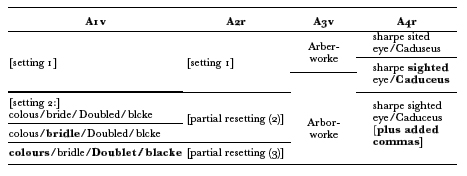 |
position to interpret the equally puzzling replacement of blocks of text on
some
pages.
§2. Headlines
ToP contains no running titles. Except for the words "The
Epistle" on a2v,
the headlines consist of simple page numbers within
parentheses—three or four
types plus spacers. Figure 2 shows two states of a page
(C1r) in which the headline
has been reset. This is not just a spacing shift—all
three printing characters are
different types. But the setting below is unchanged,
and even the direction lines
are unaltered (both contain the catchword "An_" with a dropped hyphen). On
some other pages, both the
numbers and the direction lines show resetting—
for example B3r in Houghton STC
22459 as compared with the same page in
Houghton STC 22459a.5. Still others have
page-number resettings in conjunc-
tion with stop-press corrections. On A1v,
Bodleian Mal. 160(3) has three errors
that are corrected in National Art Library
25.c.79.
15
The priority seems
clear.
However, along with the corrections comes a reset page number: originally
well
printed, the "2" in the apparently later state is badly damaged and the left
pa-
renthesis prints much thinner than the right. The nature of the damage to
the
numeral makes it unlikely that we are looking at the same unhappy type,
and
the parentheses are also clear substitutions. In the act of improving the
text, the
printer seems for no discernible reason to have swapped out a good page
number and substituted a bad one.
Finally, a new headline always appears in those cases (mentioned in the
pre-
vious section and discussed more fully in the next) where selected blocks of
text
are reset seemingly without need. Headlines are reset even when they are
not
adjacent to the reset text. Huntington copies 69434 and 69428, for
instance,
show this phenomenon on C2v.
Most of these headline replacements also entail a reset direction line,
though
the latter can be difficult to detect. Of the two features, I have found
the page
numbers to be a clearer first indicator that something unusual is going
on, for

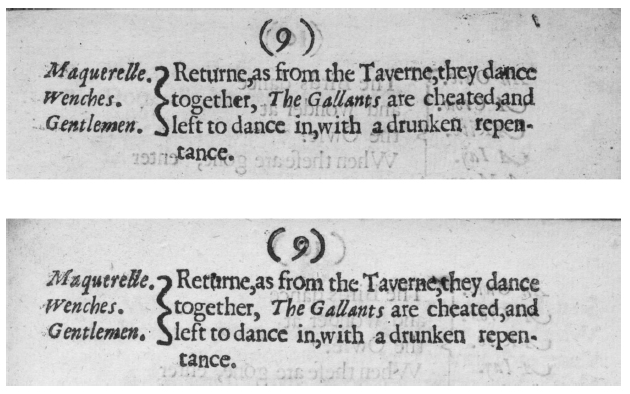
way twice; their horizontal alignment with the first line of text is variable; and
the numbers and parentheses in Norton's type-cases contain a variety of forms
and damaged sorts that make substitution easy to detect.
The page-number changes in ToP are so clearly without purpose
that they
must have been unintended consequences of other operations. We can
explore
their patterns by modifying table 1 to show where the substitutions occur.
In table
3, the double horizontal lines indicate page-number changes.
16
These obviously
occur also at the
points where whole pages are reset (still shown by changing
shades of gray), but
others divide the main settings into smaller groups. A reset
number on one page
usually accompanies a similar operation on its forme-mates,
and the table shows
corresponding fault-lines that often break out of individual
formes into whole
quires and even to the other sheets. The initial impression of
chaos in table 1
begins to yield to a pattern that is more complex, but also more orderly.
The page numbers in ToP belong to an element common to most
books
of the hand-press period called the skeleton forme. This consisted of
non-printing
material such as the furniture that held the pages in a set layout on
the press
bed, but it also included the headlines and direction lines. The latter
contained



So, the skeletons tended to get re-used, with changes to the visible type as needed,
in successive formes as an edition went through the press. When a forme was
finished printing, the units of the skeleton were normally separated from the type-
pages and used in another forme, while the stripped pages went back to the type
cases for distribution. 17 After the edition was finished, the type of the skeletons
would go down the same path.
It was entirely possible to do multiple printings of a short book using the
same
setting of type. In such a scenario, the type-pages, after their first
printing, would
be tied up with string, with or without their skeletons, for an
arbitrary period,
then reimposed and reprinted. This cycle could repeat itself as
many times as
needed. Printers commonly stripped the headlines and direction lines
when pages
were finished printing, but if the skeletons happened to remain with
their pages, a
reprint could easily escape detection even by a modern
bibliographer. Numerous
examples of reprinting from standing type, at least for
stretches of a few pages,
are documented from the early seventeenth century and
before,
18
and the prac-
tice
became rather common by the late eighteenth century. The reasons it was
not more
widespread in the 1630s were both practical and regulatory.
Between
1587 and 1637, an order of the Stationers'
Company set a limit of 1500 copies
on print runs from a single
setting.
19
If more copies were
wanted, a scrupulous
printer would have distributed the type and reset a new
edition from scratch.
This rule was intended to provide sufficient work for
journeyman compositors,
but it also made economic sense. Because hand-cast type
was expensive, a printer
would keep only limited amounts and would not want large
chunks of it tied up
and unusable for other jobs. Nevertheless, printers
interpreted the regulation
flexibly, and when faced with a sudden high demand for
a particular title they
were understandably tempted to exceed the limit.
20
If we encounter a book whose copies show only minor changes to the text
but two
entirely different settings of the running titles, we have a strong case
that the
edition went through two impressions. In the interval between them,
the skeletons
got distributed and had to be reset for the second run. This is
what I believe
happened repeatedly with The Triumph of Peace. I would contend

an interruption of work during which the whole forme was removed from the
press. The type-pages were set aside for a time and then received at least reset
page numbers, and usually new direction lines as well, in preparation for re-
impression. Some pages underwent a complete resetting during the interval, of
course including the skeleton. This is the explanation of the horizontal fractures
in table 3. It is even possible that some pages were stored with their skeletons
intact and went undetectably into later impressions. This could have occurred
with formes D(o) and A(i) at certain points in the printing history; it is tempting
to posit "silent" reimpositions that would bridge the discontinuous fault-lines in
table 3. We will explore this possibility when we go into the life-histories of the
individual quires.
I have ignored some anomalies in forme B(i) that will be
discussed in §6C. In late copies
of quire D, two settings occur
interchangeably; therefore it is not possible to diagram a clear
transition
from one to the other.
Curiously, Joseph Moxon does not
discuss this practice (Mechanick Exercises on the Whole
Art
of Printing, ed. Herbert Davis and Harry Carter. 2nd ed. London:
Oxford University Press,
1962); but the books themselves give
frequent evidence of it.
A search in ESTC for note-word "reimposed" will turn up some of
these (e.g., S92876
(1583) and S125309 (1572?). See
also Greg, English Printed Drama, entries 28(b)
(1559), 75(b)
(l578), 202(b) (l604), 203(b)
(1604), 204(b,c) (1604–05), 217(b) (l605), 230(b)
(l606), 295(b)
(1611), 296(d) (1635), 412(b)
(1625), and L18(AII) (1641?). Another probable example
is Greg
466, explored by J. Caitlin Finlayson> in
"Thomas Heywood's
Londini Artium & Scientiarum Sca-
turigo
(1632): The Huntington and Worcester Copies—Two Issues or Variant
States?" (Papers
of the Bibliographical Society of America
, 108.3 [Sept. 2014], 325–341).
A Transcript of the Registers of the Company
of Stationers of London; 1554–1640
(ed. Ed-
ward Arber). London: Privately printed, 1875–94, 2: 43. The article
limiting edition sizes was
approved on 4 December 1587 (W. W.
Greg, A Companion to Arber. Oxford: Clarendon
Press,
1967, p. 43).
§3. Italic Raids
Figure 3 shows a sort of mutation frequently found in ToP: the
entire song
(composed in italic type) has been reset, but not the passages in
roman above.
Note that short stretches of italic embedded in roman text remain
unchanged.
Eleven pages in ToP show this localized
resetting of italic at some point in the
printing history, and one of them (D2r)
has part of the italic reset yet again. Two
pages (including one that previously
had the italic changed) also show an arbi-
trary change-out of some of the roman type.
Table 4 shows where these resettings occur. (Solid arrows indicate replace-
ment
of italic type, dashed arrows the replacement of roman.) All of them, except
for
the roman replacement on C1r, occur at points in the production cycle where
the
numbers in the headlines were also reset—in other words, during the pauses
between
impressions that we have already identified. Table 5 presents the history
in
another way. (It contains codes for production phases and variant states which
I
will discuss later.) This table shows all the pages of ToP that
contain concentra-
tions of italic. A great deal of that type is used for the
songs that cluster toward
the end of the masque.
The local resettings do not always draw on the same font. In the earliest
states
of ToP, all the text—both roman and italic—is set in
"english" size (20 lines =
96 mm). In the first wave of changes, the italic Song 5
on C4V reappears in pica
size (82 mm). During the same transition, four lines of
italic stage direction on
A2v-3r switch to a 120 mm great primer. Pages C3v and
D3r are a more subtle
case: the reset songs are still in 96 mm italic, but the
font is of a different design,
which I will call i-2 as opposed to the more
prevalent i-1. The differences are
hard to describe, but we can compare the two in
figure 3. The page on the left
features Norton's regular english italic i-1, while
that on the right shows the song
reset in i-2—a less attractive face, smaller on
the body and also (in its ToP out-
ing) badly worn. The
most diagnostic feature of i-2 is the h, whose legs
nearly
close at the bottom, so that the letter resembles a b. In its i-1 cutting, the right
leg only begins to close.
None of these partial resettings result in substantive textual changes. Like
the
page-number resettings, they bear the marks not of perfectionism but rather of

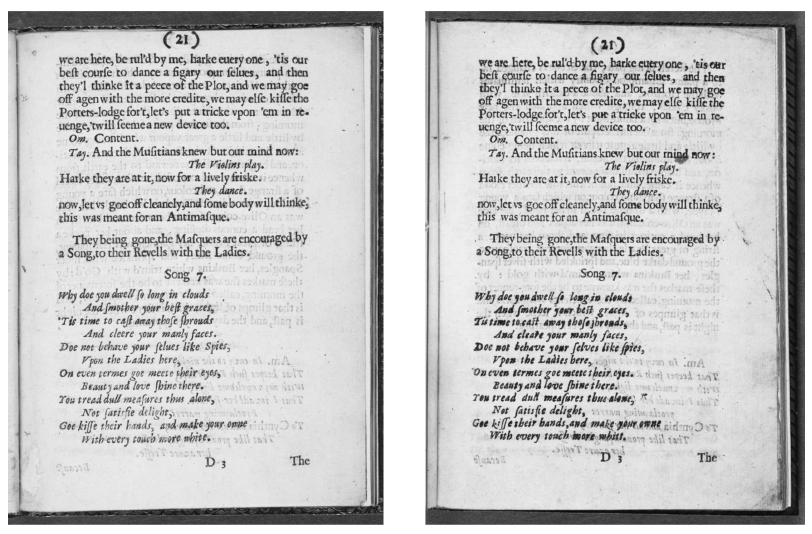

and recourse to alternative, wrongly-sized, and sometimes inferior fonts strongly
suggest that they were a response to a shortage of type, that Norton was juggling
other jobs, and that ToP had to stand aside—even sacrifice some of its stand-
ing type—to let those jobs "play through". I therefore refer to these incidents
of localized distribution as "raids", which created holes in the composition that
Norton refilled once the more pressing need was past.
In §9, I will show that some of the italic distributed in the first raid ended
up
in ToP itself, in the two pages of dedication (leaf a2).
As part of the preliminaries,
these pages would have been printed after the main
text if Norton was following
the usual practice. Once the dedication was set, on
the other hand, it remained
substantially unchanged through the remainder of ToP s printing history. Norton
was able to muster enough
italic to restore the raided pages, though he some-
times patched the holes with a
mis-matched font. The first wave of raids liberated
about 2130 ens of italic, but
the preliminary quire of ToP contains only 42% of
that,
about 900 ens. Distributing more than twice the amount of needed type
might have
been a prudent action to ensure an adequate supply of all the sorts.
If there was
another job or jobs that prompted the italic raids, I have not been
able to
identify them. The candidates would obviously contain large amounts of
Norton's
english italic (96 mm). This was a slightly unusual size for standard text;
the
smaller pica served as the workhorse. In his books dated 1633–34,
Norton
used english-sized italic mostly for matter subsidiary to the main
texts—prelim-
inaries and indexes. The most extended stretch of it comes in the
twelve-page
index of Richard Verstegan's
Restitution of Decayed Intelligence (STC 21363),
dated
1634. It contains double columns of short lines of italic
with a heavy admixture of
roman. Its requirements hardly seem enough to stretch
the resources of a print-
ing house responsible for nearly thirty known jobs, or
parts thereof, during the
two-year span with ToP at its
center. It may be safest to hypothesize that Norton
was doing some job work now
vanished, maybe longer than a single sheet, greedy
for a larger size of italic
than usual, and urgent. The fact that the raids took place
at more than one point
in the ToP production suggests either several
ephemeral
jobs, or one larger project which for some reason has not survived.
In this section I have focused on localized resettings of italic passages in
re-
sponse to a need for type, but we need to bear in mind that any distribution of
type served to make it available for other jobs. We
will see instances throughout
the printing history of ToP
in which entire pages or formes were reset, with no
discernible pattern in which
pages were chosen. At the end of each printing
phase, Norton had three choices of
what to do with each type-page: (a) distribute
it, (b) keep the text standing and
strip the skeleton, or (c) keep the text stand-
ing with the skeleton intact. It
is quite possible that many of the resettings were
motivated by a need for more
roman type, and that the selection of pages was
driven by which type-pages were
accessible when the need arose.
It is now time to look at the variants in The Triumph of Peace
in detail. The
following sections, §4–8, are the densest
portion of this article and some readers
may find in them too much of a good
thing. Once we have dealt with the book
at the level of quire, forme, and
individual page, we will pull back to see how all



| Phase | A outer | B outer | C outer | C inner | D outer | D inner | ||||||||||||||||||
| A1r | A2v | A3r | A4v | B1r | B2v | B3r | B4v | C1r | C2v | C3r | C4v | C1v | C2r | C3v | C4r | D1r | D2v | D3r | D4v | D1v | D2r | D3v | D4r | |
| I | 1 | (1) | (1) | 1 | 1 | 1 | 1 | (1) | 1a | (1) | (1) | (1) | (1) | 1a | (1a) | (1a) | 1 | 1 | (1) | 1a2 | (1) | (1) | (1) | (1) |
| II | 2a | [2a] | [2a] | 2a | 2a | 2a | 2a | (2a) | 1b | [2a] | [2a] | [2a] | 2 | 1b | (1b) | (1b) | 1 | 1 | (1) | 1a2 | [2] | [2] | [2] | {2} |
| III | 2b | 2b | 2b | 2b | 2b | 2b | 2b | (2b,c) | 1c | 2b | 2b | 2b | 3 | 2 | {2} | 1c | 2 | 2 | [2] | 1b | 3 | [3] | 3 | 3 |
| IV | [3] | |||||||||||||||||||||||
[] = only italic reset
{} = entirely reset
of the changes fit into the production sequence of multiple printings. In §9–10,
I will demonstrate how recurring types give evidence of the order of printing
the formes; in §11–14, I will show how copies were assembled from the stock
of printed sheets on hand. Section 15 presents the entire workflow as a series
of specific actions, and §16 addresses basic issues like edition size and the time
required to print all the copies. The metamorphosis of the printed pages entails
a textual evolution in which deliberate revisions (mostly to the stage directions)
appear amid a chatter of accidentals generated by the resettings. I have reserved
a detailed account of these for the textual introduction to ToP in the upcoming
Oxford University Press edition of Shirley's works.
My method of organizing the variants is, I hope, as simple as the situa-
tion
allows, but it still needs a bit of explanation. The comprehensive catalogue
of
manifestations of all the pages, from complete resettings down to stop-
press
variants and even the occasional random shift, will be found as appendix 1. It
is
modeled on a biologist's taxonomic key, and as with all such keys the
identi-
fication marks are the minimum required to distinguish the states; seldom
are
all the variants on a page mentioned. During the first stages of organizing
this
list, I saw the need for some kind of shorthand to refer to each state of a
page.
Ideally the structure of this shorthand should express the hierarchical
relation-
ships of the states of each page, with the main settings at the top
level followed
by impositions at the next and stop-press variants at the bottom.
However, as
the families of variants continued to ramify—sometimes manifesting
states that
would not fit neatly into any hierarchy—practice sometimes overruled
theory,
and the codes ceased to reflect any rigid correspondence with production
phases
or the relative importance of the changes they denote. Attempting at this
point
to revise the codes to make them more consistent—to the extent that that
would
even be possible—would render precarious their connection with notes
taken
over two decades, which embody the current system in a well-documented
pro-
cess of evolution. For specification of the exact relationships between the
states,
the reader should refer to appendix 1.

| JAMES SHIRLEY'S TRIUMPH OF PEACE:
ANALYZING GREG'S NIGHTMARE
by
STEPHEN TABOR
| ||
